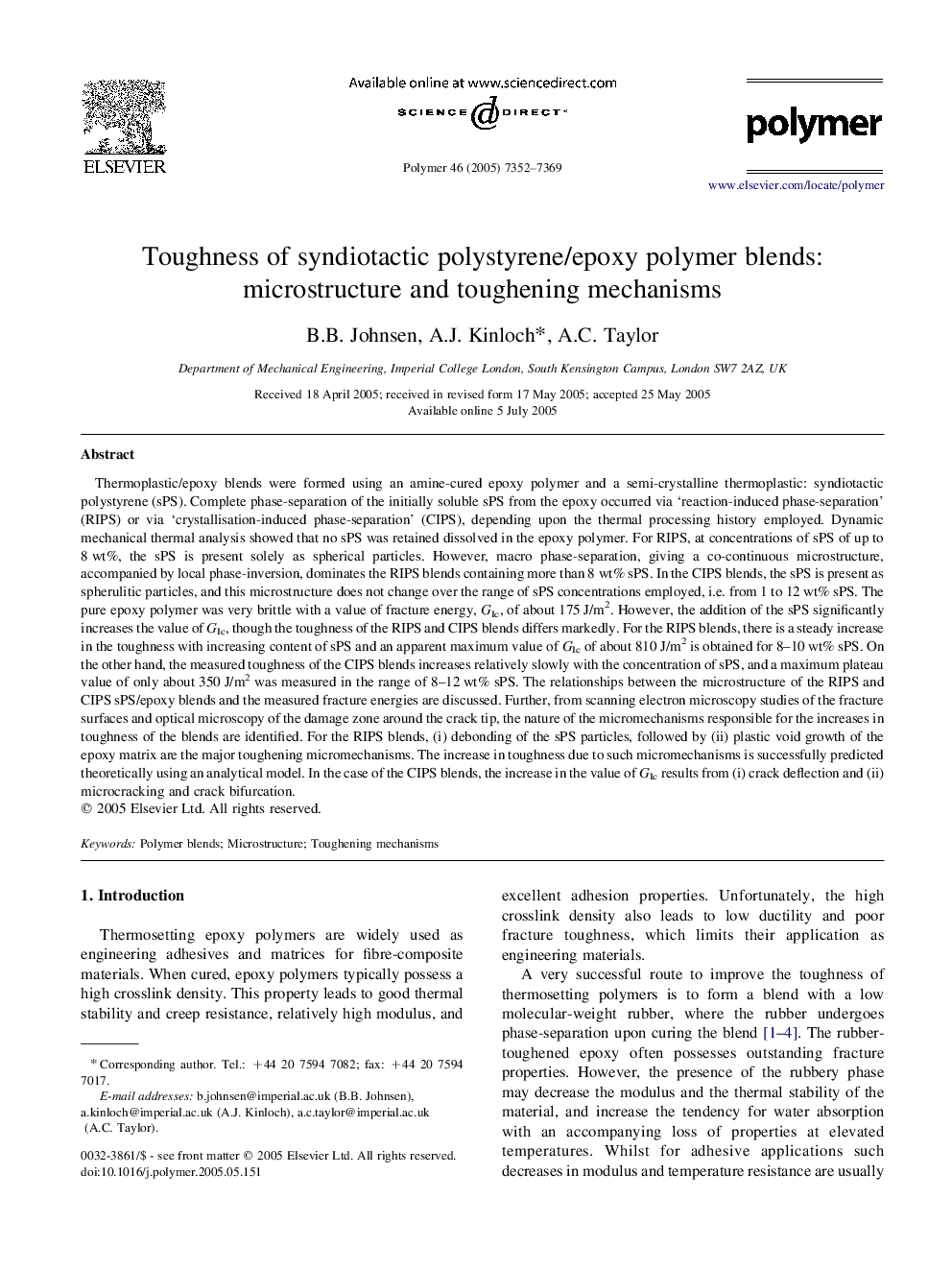| کد مقاله | کد نشریه | سال انتشار | مقاله انگلیسی | نسخه تمام متن |
|---|---|---|---|---|
| 5191229 | 1381228 | 2005 | 18 صفحه PDF | دانلود رایگان |
عنوان انگلیسی مقاله ISI
Toughness of syndiotactic polystyrene/epoxy polymer blends: microstructure and toughening mechanisms
دانلود مقاله + سفارش ترجمه
دانلود مقاله ISI انگلیسی
رایگان برای ایرانیان
کلمات کلیدی
موضوعات مرتبط
مهندسی و علوم پایه
شیمی
شیمی آلی
پیش نمایش صفحه اول مقاله

چکیده انگلیسی
Thermoplastic/epoxy blends were formed using an amine-cured epoxy polymer and a semi-crystalline thermoplastic: syndiotactic polystyrene (sPS). Complete phase-separation of the initially soluble sPS from the epoxy occurred via 'reaction-induced phase-separation' (RIPS) or via 'crystallisation-induced phase-separation' (CIPS), depending upon the thermal processing history employed. Dynamic mechanical thermal analysis showed that no sPS was retained dissolved in the epoxy polymer. For RIPS, at concentrations of sPS of up to 8Â wt%, the sPS is present solely as spherical particles. However, macro phase-separation, giving a co-continuous microstructure, accompanied by local phase-inversion, dominates the RIPS blends containing more than 8Â wt% sPS. In the CIPS blends, the sPS is present as spherulitic particles, and this microstructure does not change over the range of sPS concentrations employed, i.e. from 1 to 12Â wt% sPS. The pure epoxy polymer was very brittle with a value of fracture energy, GIc, of about 175Â J/m2. However, the addition of the sPS significantly increases the value of GIc, though the toughness of the RIPS and CIPS blends differs markedly. For the RIPS blends, there is a steady increase in the toughness with increasing content of sPS and an apparent maximum value of GIc of about 810Â J/m2 is obtained for 8-10Â wt% sPS. On the other hand, the measured toughness of the CIPS blends increases relatively slowly with the concentration of sPS, and a maximum plateau value of only about 350Â J/m2 was measured in the range of 8-12Â wt% sPS. The relationships between the microstructure of the RIPS and CIPS sPS/epoxy blends and the measured fracture energies are discussed. Further, from scanning electron microscopy studies of the fracture surfaces and optical microscopy of the damage zone around the crack tip, the nature of the micromechanisms responsible for the increases in toughness of the blends are identified. For the RIPS blends, (i) debonding of the sPS particles, followed by (ii) plastic void growth of the epoxy matrix are the major toughening micromechanisms. The increase in toughness due to such micromechanisms is successfully predicted theoretically using an analytical model. In the case of the CIPS blends, the increase in the value of GIc results from (i) crack deflection and (ii) microcracking and crack bifurcation.
ناشر
Database: Elsevier - ScienceDirect (ساینس دایرکت)
Journal: Polymer - Volume 46, Issue 18, 23 August 2005, Pages 7352-7369
Journal: Polymer - Volume 46, Issue 18, 23 August 2005, Pages 7352-7369
نویسندگان
B.B. Johnsen, A.J. Kinloch, A.C. Taylor,